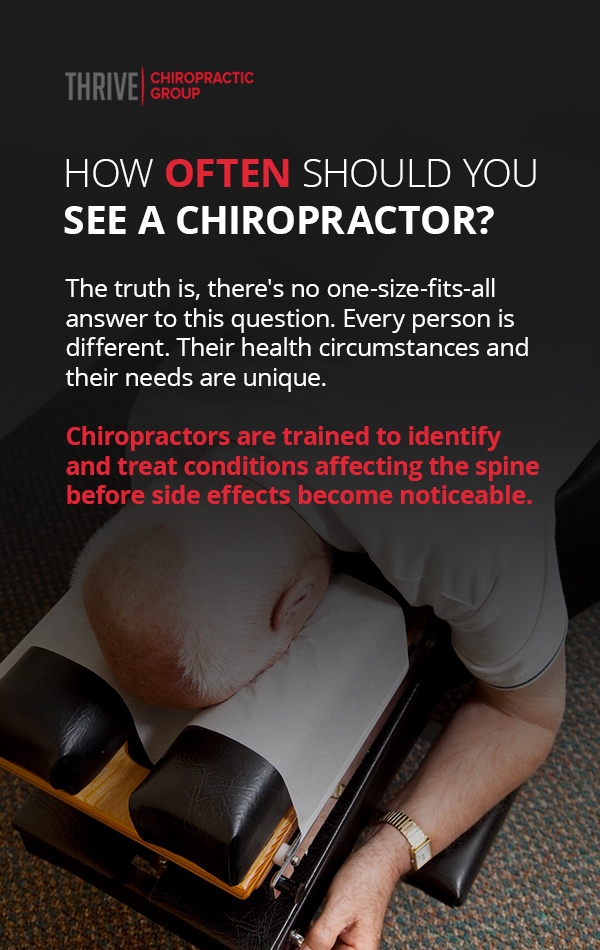When to Start Chiropractic Treatments
If you have a toothache, you wouldn’t just ignore it. By the time the tooth hurts, we know that the cavity took months to decay. So why are you ignoring the pain in your back? Pain is your body’s way of telling you that something isn’t right. It’s not something you should live with on a regular basis. But many people experience chronic pain — concerns that last longer than 12 weeks, even with medical intervention — at some point in their lives.
If you’re suffering from chronic back pain or other short-term musculoskeletal pain, you may be a prime candidate for chiropractic care. But chiropractic care isn’t just designed to relieve your pain, although it certainly does. This option can identify and address the underlying cause of your pain. If you’re looking for relief, learn more about when to start chiropractic treatments below.
When to See a Chiropractor
Besides getting to the root of chronic pain, chiropractic care also offers a safe and effective alternative to medicating the pain away. One recent study found that patients who received chiropractic care for their back pain before visiting a medical provider were 90% less likely to require opioid pain medication to address their pain.
Chiropractic care can be beneficial to one’s overall health and wellbeing. But many people aren’t sure when to see a chiropractor, or they wait until they’re in excruciating pain.
So when should you see a chiropractor? Don’t wait until you can barely walk to the phone to make an appointment. It’s time to see a chiropractor if you’re experiencing:
1. Neck or Back Pain
A misalignment of the musculoskeletal system can often cause pain in your joints and muscles. If your neck or back hurts and you might take ibuprofen or aspirin to alleviate your symptoms. But those medications are simply designed to manage the symptoms of a problem. They aren’t meant to treat and resolve the cause of the pain that you’re experiencing.
Regular chiropractic care can return these muscles and joints to proper alignment. It can also increase nerve conduction and blood flow to the muscles and joints that are in pain. You might strengthen your muscles, joints and ligaments, as well, to prevent pain and discomfort in the future.
Wondering when to seek a chiropractor for back pain? If you are wanting a non-surgical treatment option, then a consultation with an experienced chiropractor can put you on the road to healing.

2. Tension Headaches
Headaches can have a number of causes. Tension headaches are frequently associated with stress, which can manifest itself in physical symptoms, such as tight muscles, poor posture and a clenched jaw. These headaches are infamous for also causing pain in the jaw, neck and shoulders. With over 80% of headaches being caused by a neck issue, tension headaches aren’t just about stress. Tension headaches are often confused with migraines because of the level of debilitating pain they can cause.
A misalignment of the spine can contribute to — or often cause — these painful headaches. A chiropractic adjustment can reduce muscle tension, restore normal joint motion, and improve the body’s blood flow and the amount of oxygen reaching your brain. That result can ease the tension and pressure in the affected muscles and ultimately help get rid of these headaches.
3. Chronic Pain
Approximately 50 million people in the United States suffer from chronic pain. Although chronic back pain is one of the most common forms, chronic pain can exist in other areas of the body, as well. Often people confuse chiropractors as only being “back doctors” however they are trained to address problems in most joints of the body like your feet, knees, shoulders and many others.
Chiropractic care can help relieve and repair the source of chronic pain. Using chiropractic care to manage chronic pain has been shown to reduce the need for medication and surgical intervention. That result can help you save money and reduce the strain on your physical and mental health.
4. Fatigue or Lack of Energy
Everyone gets tired when they stay up too late or exert a lot of physical activity. If you’re one of the potentially millions of Americans suffering from myalgic encephalomyelitis/chronic fatigue syndrome (ME/CFS), the lack of energy and extreme fatigue you feel on a regular basis can be debilitating.
Regular chiropractic care can reduce the pain and joint inflammation associated with ME/CFS. Patients who undergo regular chiropractic care for this condition report decreased pain, increased energy and improved flexibility.
5. Numbness or Tingling
Various conditions can cause unpleasant sensations — or a lack of sensation — in your fingers, toes, arms or legs. You might have a pinched or compressed nerve, neck or lower back injury or a variety of other medical conditions. In most cases, the causes of these unpleasant sensations aren’t life-threatening, but they do require attention to address and resolve the issue.
A chiropractor can help rule out the cause of your problem and develop a treatment plan to fix it. The goals will be to alleviate the uncomfortable sensations you’re experiencing and treat the source of the problem. Chiropractic treatment plans for these sensations are designed to correct the misalignments that may be putting pressure on muscles and joints, as well as reduce nerve irritation.

6. Digestive Problems
When people think of chiropractic care, they usually think of the spine, not the digestive system. But studies have shown that routine chiropractic care can also help treat a variety of digestive issues, including heartburn, constipation and irregular bowel movements. When the spine isn’t aligned, the central nervous system cannot operate properly. When it doesn’t operate as it should, it can send improper signals to the digestive system, resulting in uncomfortable or inconvenient conditions. Though often seen in adults, this is commonly seen in small children and is referred to as cholic.
At its core, chiropractic care is designed to treat and improve the body’s central nervous system through treatments designed to properly realign the spine. If you’re suffering from heartburn, constipation or irregular bowel movements, chiropractic care can provide long-term relief without the use of harsh medications.
7. Childhood or sports injuries
Many people think that only adults can see a chiropractor. However, many chiropractors have undergone specific training to help with childhood and sports injuries. When you damage the body or spine at a young age, many adults give the child something for pain but never address the injury. These childhood injuries show up later as adults because your body has been compensating for 20 years and that damage adds up over time.
The average child, by age 6, has taken 3,000 falls. Add in trauma from birth and then sports and you have quite a few injuries to the body at a very young age. Even worse, the average child spends 8-9 hours per day looking down at technology. This puts their spine in an abnormal position for an incredible amount of time and has been shown to cause damage over years. This has commonly been referred to as Tech Neck.
When Not to See a Chiropractor
Chiropractic care is designed to help restore proper function in the musculoskeletal and central nervous systems. But there are times when a patient is suffering from an acute condition that requires medical intervention of a different variety. In many cases, it’s essential to determine the cause of your pain — or at least rule out potentially serious causes of pain — before beginning chiropractic care.
Chiropractors can help to manage and resolve pain for a number of issues, but sometimes need to rule out more serious conditions through x-rays, MRIs, CTs, or other diagnostic testing to ensure chiropractic care is the right path to take for your health.
1. Ruptured Disc
Can a chiropractor help with back pain? Generally speaking, yes. But certain back pain causes need to be evaluated and sometimes treated by a physician first.
A herniated disc, also referred to as a “slipped disc,” occurs when the soft inner portion of one of your spinal discs protrudes through the tough outer layer. This condition can be caused by injury or simply a breakdown of tissues as the body ages. Being overweight can also put adults at higher risk for experiencing a slipped disc.
When a disc becomes herniated, it can put pressure on the nerves in the spine, causing a lot of discomfort. In some cases, the pain associated with a herniated disc can be alleviated with physical therapy. More severe cases may require surgery.
Though chiropractic care can help many disc injuries, an MRI may be ordered by your chiropractor to rule out a tear or rupture that may need surgery before any care can be given.
2. Broken Bones
A broken bone is identified by sudden, intense pain after a mishap or accident, swelling, bruising, redness and an inability to move a particular limb. In some severe cases, a bone may also protrude through the skin. But a bone break needs to be treated and set properly to heal. In the case of a severe break, surgery may even be necessary. You might seek treatment at a hospital or clinic, depending on where you live and the physician overseeing your care.
Chiropractors may not play a role in setting a broken bone, but they can be an important part of the healing process. A broken bone can cause subluxation — misalignment of the spine — during healing, which can cause discomfort, pain and other long-term complications. Chiropractic care can also be used after a broken bone is healed to improve circulation and balance, reducing your chances of sustaining another injury later. Most chiropractors utilize x-rays in their office to rule out fracture before providing care or treatment.
3. Osteoporosis
Osteoporosis is a disease that causes bones to lose too much density and puts older adults at risk for bone fractures and other serious health issues. Breaking a hip can be especially problematic because it can permanently impact mobility.
Chiropractic care has been found to be an effective tool in managing the pain and discomfort associated with osteoporosis. But chiropractors need to know of an osteoporosis diagnosis before working on a patient because they need to make certain adjustments to common treatments. If you suspect you have osteoporosis, your physician can run tests to diagnose your condition before you undergo chiropractic care. If osteoporosis is found, your chiropractor will modify the care given to safely take care of you.
Preventative Care With Chiropractic Treatment
While chiropractors can help with a variety of medical conditions, they also offer preventative care. In other words, chiropractic treatments can help prevent problems later. Preventative care may seem odd if you’ve only prioritized going to the doctor when you’re sick or in pain. But most patient’s participate in preventative care daily when they brush their teeth. You are not waiting for the tooth to decay and hurt to start brushing, you brush daily to keep them healthy. We often don’t think about protecting our bodies so we don’t get sick or hurt later. But what if you could help avoid pain — and all the medical bills associated with treatment — before it even happens? That’s where a chiropractor visit can help.
How Often Should You See a Chiropractor?
The truth is, there’s no one-size-fits-all answer to this question. Every person is different. Their health circumstances and their needs are unique. The best way to determine how often you should see a chiropractor is to schedule a consultation. We always recommend not waiting until you’re in pain to schedule an appointment, since that means the damage has already occurred and may require additional care to help fix the problem.
Chiropractors are trained to identify and treat conditions affecting the spine before side effects become noticeable. They can identify subluxations or misalignments in the spine that may not yet be causing pain or discomfort. By regularly returning the body to proper alignment, chiropractic care can reduce the occurrence of pain and injuries associated with muscle misalignment or weakness.
One of our favorite questions is, “Can you go to the chiropractor just because?” When it comes to managing your health and living a healthy lifestyle, there’s never a “just because.” It’s always a good time to consult with a chiropractor about how they can help you maintain good health. Just like brushing your teeth daily, taking care of your spine and health on a regular basis is always a good idea.
What Can a Chiropractor Help With?
Chiropractors don’t only help prevent and treat pain through regular adjustments. They can also advise patients on how to improve posture and nutrition to help reduce inflammation and the occurrence of chronic back pain. Chiropractors can also offer guidance on sleeping positions and mattress types to help improve the quality of your sleep. When you sleep better, you’re less likely to experience headaches or back pain.
Chiropractic care is also an important tool for athletes because it helps strengthen their joint mobility and musculoskeletal systems, improving their skills and preventing injury while playing. Ongoing chiropractic care can also identify the source of pain. An athlete may be experiencing pain in their hip, but a chiropractor can identify misalignment in another area of the body that may be contributing to the issue.
Chiropractic care is often utilized for automobile and workplace accidents to help the injured employee return to work quickly and without needing surgery. Several studies have shown chiropractic care following these injuries provided a quick return to normal work and reduced need for pain medication and surgery.
Should You See a Chiropractor for Problems that Aren’t in the Spine?
Many times, people assume if their pain and discomfort aren’t in their back, a chiropractor can’t help. The truth is that our bodies are complex and interconnected systems. Pain in your shoulder or hip may actually be the result of a misalignment in your spine. Or the joint itself could be damaged and may need chiropractic care directly. As doctors, chiropractors can perform an examination, take x-rays, order MRIs or refer to another doctor or specialist if necessary.
Quality Chiropractic Care in Oklahoma City
Can you go to a chiropractor for no reason? Even if you’re not currently experiencing chronic pain, there’s no time like the present to start working with a chiropractor to manage your health. Preventative adjustments can save you a lot of time, money and pain down the road by preventing problems before they start.
Thrive Chiropractic Group is proud to serve Oklahoma City and its nearby communities. Offering three convenient locations, Thrive Chiropractic Group is dedicated to helping you take control of your health. Remember — pain isn’t a lifestyle! If you’re living with chronic pain or constantly taking medications to ease your symptoms, our dedicated staff is ready to help.
Interested in chiropractic treatment? Call or fill out a contact form to schedule an appointment at one of our offices today.



